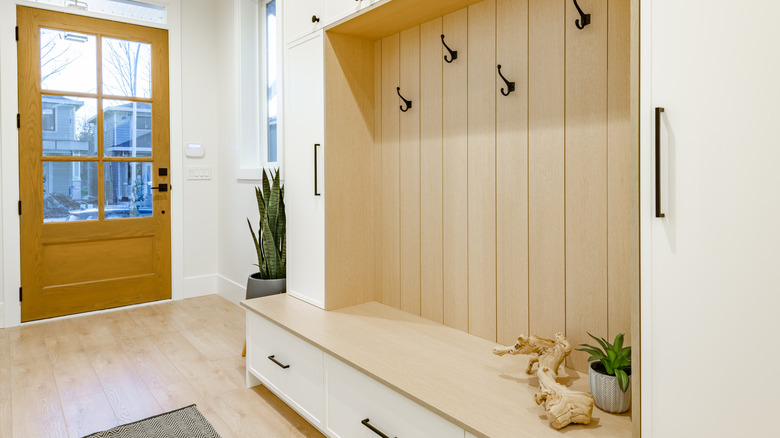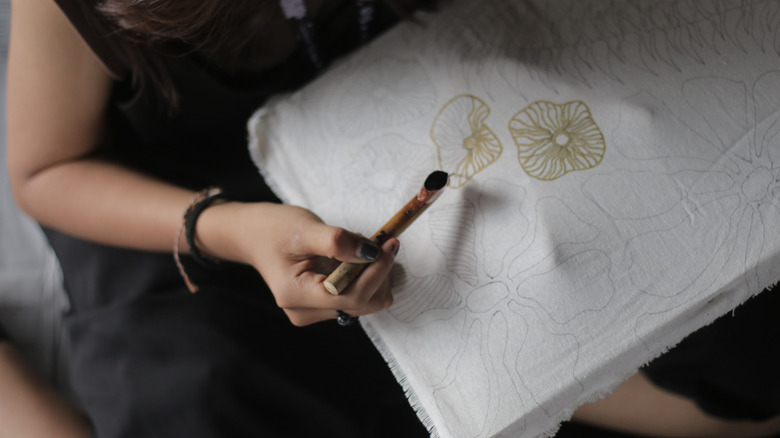How To DIY A No-Sew Bench Cushion For Charming Home Decor On A Budget
We may receive a commission on purchases made from links.
One of the most practical furniture options that's seen an upward trend in recent years is bench seats. The big plus with this type of seating is that it provides you with more usable space than chairs. However, when they don't have cushions, sitting on them for long periods of time gets pretty uncomfortable. Fortunately, if you're handy with simple tools like scissors and a staple gun, you could DIY the cushion. Whether you are upgrading hard seating in the house or want to turn an unused coffee table into a cozy bench, this simple project can be completed in an afternoon.
For this DIY, you'll need a tape measure to size the bench and the materials to cover it. A piece of plywood (½- or ¾-inch thickness will work) that fits the length and width of the bench's seat will be the cushion's structural base. If you have the equipment to cut the board, do that yourself. If you don't, take advantage of one of the best DIYer-friendly Home Depot hacks that you may or may not know about: the Cutting Center, a place where someone will cut the board for you.
Your bench seat also requires batting, like LNJMRU Quilted Cotton Polyester Padding, and enough seat cushion foam to cover the bench's seat. To work with those items, you'll need a pair of scissors. The project additionally calls for fabric. Get enough to cover the wood plus a little extra, perhaps 6 inches to a foot extra on all sides to be safe. Finally, in lieu of a sewing machine, you'll need an upholstery staple gun and some spray-on adhesive glue, such as AK TRADING CO. Multipurpose Spray Adhesive, to bring this project together.
Constructing your no-sew bench cushion
Once you have the board cut to the bench's size, you'll need to measure the foam pads that provide cushioning, the cotton-polyester padding, and the fabric that you'll use to cover the bench seat. The seat cushion foam, such as GoTo Foam Upholstery Cushions, needs to be cut to the exact length and width of the board. Once the foam is cut, glue it onto the board with the spray-on adhesive. Spray adhesive on the plywood and the foam, covering the sides that will be bonded together. Press the foam onto the plywood, and let the adhesive dry.
Cover the cushioned board with the cotton-poly padding. Cut the padding so it completely covers the top and sides of the foam with at least 4 to 6 inches to spare on all sides. This extra will wrap over the sides and get stapled to the bottom side of the board. The simplest way to do this is to staple one end of the batting to the underside of the plywood, making sure that the staples are secure. Next, staple down the padding on the opposite side, pulling it tight-ish. You don't want lumps. Then, staple the padding on the ends. To do this, fold the corners in, and then fold the end over (much like wrapping a present) before stapling the padding to the plywood.
Next, cut the fabric the same way you cut the padding, leaving a little extra on all sides. It's critical that fabric gets pulled down tight. This helps to avoid bumps and wrinkles in the finished product. Repeat the same steps until the fabric is fastened to the board.
Other tips and considerations for this DIY
Even though this bench seat doesn't require sewing, that doesn't mean it can't be further dressed up. Many cushions have exposed upholstery tacks that run along the base of a cushion. These can serve a construction function, but they are typically more for decoration. If you'd like to add some to your bench cushion to give it some more traditional character, you'll want to take a look at different kinds of decorative upholstery pins, like Maozaa Pumpkin-Shaped Decorative Upholstery Tacks. Adding this kind of embellishment dresses up your seat and requires no sewing.
Finally, you have the option to paint and stencil on the fabric with tools like HUAL Fabric Paint. If you're into shabby chic or looking for a timeless farmhouse aesthetic to elevate your decor, giving your build the old Matisse touch adds new personality to the cushion and is in keeping with the no-sew parameters of the project. This is a fitting option if you're not into embroidery but you still want to infuse your DIY cushioned bench with more of your unique flair.

